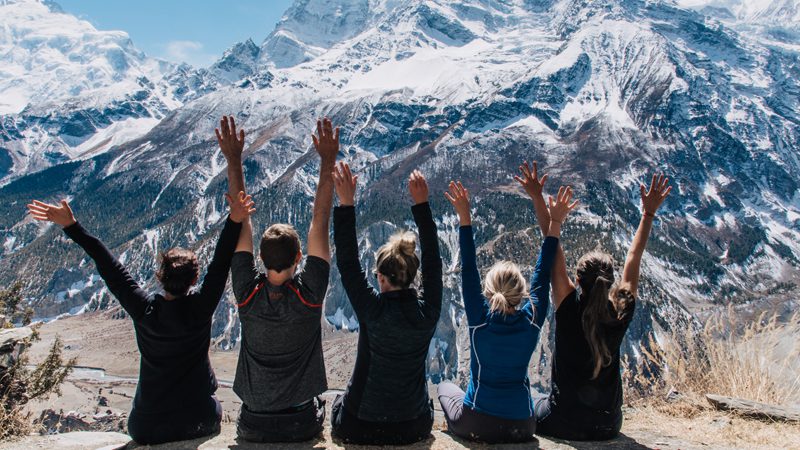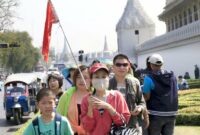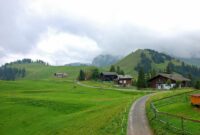Small group travel for seniors represents a significant shift in the travel industry, catering to the specific needs and desires of a growing demographic. This approach offers a unique blend of adventure, cultural immersion, and relaxation, all while prioritizing comfort, safety, and accessibility. Unlike large tour groups, small group travel allows for a more personalized and intimate experience, fostering camaraderie among fellow travelers and providing ample opportunity for meaningful interactions with local communities and environments. This guide delves into the multifaceted aspects of small group travel for seniors, exploring its benefits, planning considerations, and the key elements that contribute to a successful and enriching journey.
We’ll examine the various types of small group tours available, from adventurous expeditions to relaxing cultural explorations, highlighting suitable destinations and activities for each. Furthermore, we’ll address crucial logistical aspects such as travel insurance, accommodation choices, and the importance of clear communication and pre-trip briefings. A significant focus will be placed on accessibility and inclusivity, ensuring that tours cater to the diverse needs and abilities of senior travelers. Finally, we’ll explore effective marketing strategies for promoting these specialized tours and analyze case studies of successful ventures in this niche market.
Benefits of Small Group Travel for Seniors
Choosing a smaller group for your senior travel experience offers significant advantages over larger tour groups. The intimacy and personalized attention provided create a more relaxed and enjoyable trip, allowing seniors to fully immerse themselves in the destination and connect with fellow travelers on a deeper level. This approach caters specifically to the unique needs and preferences of older adults, enhancing both the physical and emotional aspects of their journey.
Smaller group sizes translate directly into a more personalized and flexible travel experience for seniors. Unlike larger tours, where individual needs often get overlooked, small group travel allows for greater attention to detail and a more customized itinerary. This is particularly beneficial for seniors who may have specific mobility or health concerns.
Enhanced Interaction and Camaraderie
Intimate group settings foster a stronger sense of community among travelers. With fewer people, it’s easier to form meaningful connections with fellow participants and the tour guide. This leads to richer conversations, shared experiences, and lasting friendships, making the journey more enjoyable and memorable. The smaller dynamic allows for spontaneous interactions and the development of a comfortable, supportive atmosphere, unlike the impersonal nature often found in larger tours. For example, imagine a small group of eight sharing stories and laughter over a delicious meal in a local restaurant, a far cry from the rushed, impersonal dining experience in a large group setting.
Activities Suitable for Small Group Travel
Many activities are better suited to small group travel, particularly for seniors. For example, exploring charming, historic towns often involves navigating narrow streets and staircases; a smaller group can move more easily and efficiently through these spaces without the delays and congestion of a large tour. Similarly, private guided tours of museums or historical sites allow for a more personalized and in-depth experience, with the guide tailoring the information to the group’s interests and pace. A private wine tasting experience in a vineyard, allowing for ample time to sample wines and engage with the vintner, is another excellent example of an activity that thrives in a small group setting. These experiences provide a more intimate and fulfilling experience compared to the rushed, superficial interactions that often occur in larger groups.
Addressing Mobility and Health Concerns
Small group travel directly addresses the potential mobility and health concerns of many senior travelers. The smaller size allows for a more flexible itinerary, enabling adjustments to be made easily to accommodate individual needs. The tour guide can pay closer attention to each participant’s well-being, ensuring that everyone is comfortable and safe throughout the journey. For instance, if a participant experiences fatigue, the group can take a break or adjust the schedule without disrupting the entire tour. Similarly, the smaller group allows for easier access to assistance if someone requires medical attention or has a mobility issue; the guide and fellow travelers can readily provide support. Consider a situation where a senior needs assistance navigating cobblestone streets; a smaller group can easily provide that support, whereas a large group might struggle to effectively assist.
Types of Small Group Tours for Seniors
Choosing the right small group tour can significantly enhance a senior’s travel experience. The ideal tour depends on individual preferences, physical capabilities, and desired level of activity. Consideration should be given to the balance between exploration, relaxation, and social interaction. This section categorizes various tour types to help seniors find their perfect fit.
Adventure Tours for Seniors
Adventure tours cater to active seniors who enjoy exploring the outdoors and pushing their limits in a safe and supportive environment. These tours often involve moderate physical activity, such as hiking, biking, or kayaking, combined with cultural immersion. Destinations might include national parks like Banff National Park in Canada, offering scenic hikes and wildlife viewing, or the stunning landscapes of Costa Rica, perfect for gentler rainforest treks and zip-lining experiences (for those comfortable with it). Activities could include guided nature walks, birdwatching excursions, or gentle river rafting. Safety is paramount, with tours often utilizing experienced guides and well-maintained equipment.
Cultural Tours for Seniors
Cultural tours focus on enriching experiences, emphasizing historical sites, museums, and local traditions. These tours are perfect for seniors interested in learning about different cultures and exploring historical landmarks at a relaxed pace. Destinations might include Italy, with its rich history and art, or Japan, renowned for its ancient temples and modern cities. Activities could involve guided museum tours, cooking classes focusing on local cuisine, visits to historical sites, and opportunities to interact with local artisans. The emphasis is on learning and understanding different cultures, often including opportunities for deeper engagement through interactions with local communities.
Relaxation Tours for Seniors
Relaxation tours prioritize comfort and rejuvenation. These tours are designed for seniors who prefer a slower pace, focusing on relaxation and well-being. Destinations might include luxurious resorts in the Caribbean, offering spa treatments and pristine beaches, or serene countryside retreats in Tuscany, Italy, allowing for leisurely exploration of vineyards and charming villages. Activities could include spa treatments, yoga sessions, leisurely walks, wine tasting, and opportunities for quiet reflection. The goal is to provide a tranquil and restorative experience, reducing stress and promoting relaxation.
| Tour Type | Suitable Destinations | Typical Activities | Target Audience |
|---|---|---|---|
| Adventure | Banff National Park (Canada), Costa Rica | Hiking, biking, kayaking, wildlife viewing, zip-lining | Active seniors with moderate physical fitness |
| Cultural | Italy, Japan | Museum tours, cooking classes, historical site visits, interaction with local artisans | Seniors interested in history, art, and culture |
| Relaxation | Caribbean resorts, Tuscan countryside (Italy) | Spa treatments, yoga, leisurely walks, wine tasting | Seniors seeking rest, rejuvenation, and a peaceful experience |
Planning and Logistics for Small Group Senior Travel
Planning a small group tour for seniors requires meticulous attention to detail, ensuring a smooth and enjoyable experience for all participants. Careful consideration of various logistical aspects is crucial for minimizing stress and maximizing the enjoyment of the trip. This involves several key steps, from booking flights and accommodation to arranging transportation and activities.
Essential Steps in Planning a Small Group Senior Tour
Effective planning is paramount to a successful senior group tour. This begins with defining the trip’s purpose and destination, considering the group’s interests and physical capabilities. Next, a detailed itinerary should be created, outlining daily activities, travel times, and potential rest periods. This itinerary should be flexible to accommodate unexpected events or individual needs. Booking flights and accommodation well in advance is crucial, especially during peak seasons, to secure favorable rates and preferred options. Finally, arranging transportation within the destination, whether through pre-booked shuttles or local taxis, is essential for convenience and ease of movement for the group.
Travel Insurance and Medical Assistance for Senior Travelers
Comprehensive travel insurance is non-negotiable for senior travelers. Policies should cover medical emergencies, including hospitalization, evacuation, and repatriation. Consider policies that offer 24/7 emergency assistance services and cover pre-existing medical conditions, where possible. It’s advisable to provide participants with a list of local medical facilities and emergency contact numbers. Additionally, informing participants of the location of the nearest embassy or consulate is a prudent safety measure. For groups with specific medical needs, it’s beneficial to arrange for a medical professional to accompany the group or to have a detailed medical plan in place.
Accommodation Options Suitable for Senior Travelers
Choosing suitable accommodation is critical for the comfort and well-being of senior travelers. Hotels and resorts should be selected based on accessibility features, such as elevators, ramps, and grab bars in bathrooms. Rooms should be spacious enough to accommodate mobility aids and offer easy access to amenities. Consider hotels with accessible restaurants and common areas. Furthermore, proximity to key attractions and transportation hubs can significantly improve the experience, minimizing the need for extensive travel and reducing potential fatigue. Options such as retirement communities with resort-style amenities could be considered for longer trips.
Pre-Trip Briefings and Communication
Clear and consistent communication is key throughout the planning and travel process. A pre-trip briefing is essential to address all logistical details, including flight information, accommodation details, and the daily itinerary. This briefing should also cover important safety guidelines, emergency procedures, and contact information for tour guides and emergency services. Regular updates and communication channels, such as a dedicated WhatsApp group or email list, should be established to keep participants informed and allow for quick responses to any queries or concerns. This fosters a sense of community and ensures everyone feels supported and well-informed throughout the journey.
Accessibility and Inclusivity in Small Group Senior Travel
Small group tours offer a unique opportunity to cater to the diverse needs and preferences of senior travelers. However, ensuring accessibility and inclusivity requires careful planning and a commitment to providing a positive and enriching experience for everyone. This involves addressing varying mobility levels, diverse interests, and potential sensory limitations, creating a welcoming and enjoyable travel experience for all participants.
Ensuring Accessibility for Seniors with Varying Mobility Needs
Tour operators can significantly enhance accessibility by carefully selecting accommodations, transportation, and tour activities. Hotels should offer accessible rooms with features like roll-in showers, grab bars, and wider doorways. Transportation should include vehicles equipped with ramps or lifts for wheelchair users, and sufficient space for those using mobility aids. Tour itineraries should minimize strenuous activities and incorporate rest stops as needed. Consider offering alternative options for activities, such as guided tours of museums instead of extensive walking tours, or providing comfortable seating during longer travel days. For example, a tour of historical sites might include a wheelchair-accessible bus for transportation between locations, with ramps and assistance provided for entry to buildings.
Inclusive Practices to Cater to Diverse Senior Traveler Requirements
Inclusive practices extend beyond physical accessibility. Tour operators should consider the cognitive and sensory needs of participants. This includes providing clear and concise information in multiple formats, such as large-print materials or audio descriptions. Tours should be paced appropriately, allowing ample time for exploration and rest. Offering varied activities to cater to different interests, such as cultural visits, nature walks, and relaxing spa days, ensures engagement for all. For instance, a tour could include a visit to a local art gallery, followed by a relaxed afternoon tea, allowing participants to choose activities that best suit their energy levels and preferences. Dietary restrictions and allergies should also be accommodated, providing clear menu options and alternatives.
Strategies to Make Tours Engaging for Seniors with Different Interests and Abilities
Engagement is crucial for a positive travel experience. Offer a range of optional activities to allow seniors to choose experiences aligned with their interests and physical capabilities. Provide opportunities for social interaction, such as group dinners or optional workshops, to foster a sense of community. Incorporating storytelling and interactive elements into tours can enhance engagement, catering to diverse learning styles. For example, a historical walking tour could incorporate storytelling from local residents, while a nature tour could include hands-on activities such as bird watching or nature photography. Offering pre-trip information packets with detailed itineraries, maps, and contact information allows seniors to prepare and feel more comfortable and in control.
Accessibility Checklist for Tour Operators
Before launching a tour, a thorough accessibility assessment is crucial. This checklist provides a framework for operators to ensure their tours are inclusive and accessible:
| Category | Checklist Item | Action |
|---|---|---|
| Accommodation | Accessible rooms available? | Confirm availability and features (roll-in showers, grab bars etc.) |
| Transportation | Wheelchair-accessible vehicles? | Confirm vehicle type and accessibility features (ramps, lifts etc.) |
| Activities | Pace of activities appropriate for seniors? | Adjust itinerary to include rest stops and alternative options. |
| Information | Information available in multiple formats? | Provide large print, audio descriptions, and simplified language. |
| Dietary Needs | Dietary restrictions accommodated? | Provide clear menu options and cater to allergies and preferences. |
| Support | Emergency assistance readily available? | Provide contact information and emergency procedures. |
Marketing and Promotion of Small Group Senior Travel
Successfully marketing small group senior travel requires a targeted approach that resonates with the specific needs and desires of this demographic. Understanding their priorities – comfort, safety, social interaction, and enriching experiences – is crucial for crafting compelling marketing materials and choosing effective distribution channels.
Effective marketing hinges on highlighting the unique benefits of small group tours for seniors, emphasizing the value proposition beyond simply visiting a destination. This involves showcasing the personalized service, the opportunity for deeper connections with fellow travelers, and the curated experiences designed for a more relaxed and enjoyable pace.
Marketing Materials Highlighting Unique Selling Points
Marketing materials should clearly communicate the advantages of small group travel for seniors. This includes emphasizing smaller group sizes for a more intimate and personalized experience, highlighting the expertise and experience of tour guides specifically trained to cater to senior travelers, and showcasing itineraries designed with the physical capabilities and interests of seniors in mind. Brochures and website copy should emphasize the focus on comfort, safety, and ease of travel, highlighting features like comfortable transportation and accessible accommodations. Testimonials from past travelers can provide powerful social proof. For example, a brochure might feature a quote such as: “The small group size allowed me to truly connect with my fellow travelers and our guide, creating memories I’ll cherish forever.”
Effective Channels for Reaching the Target Audience
Reaching the target audience requires a multi-channel strategy. Print advertising in publications geared towards seniors, such as AARP The Magazine, remains relevant. However, digital marketing plays a crucial role. Social media platforms like Facebook and Instagram, with their targeted advertising options, are effective for reaching specific age demographics and interests. Partnerships with travel agencies specializing in senior travel can expand reach significantly. Email marketing campaigns, targeting existing customer lists and those who have shown interest in senior travel, can nurture leads and drive conversions. Furthermore, collaborations with retirement communities and senior centers can provide access to a highly relevant audience.
Sample Marketing Copy Emphasizing Benefits
Consider this sample marketing copy for a small group tour to Tuscany: “Experience the beauty of Tuscany at your own pace. Our small group tour ensures personalized attention and a relaxed travel experience. Enjoy breathtaking scenery, delicious cuisine, and the company of like-minded travelers, all while traveling comfortably and safely.” Another example, for a tour focusing on cultural experiences: “Uncover the secrets of ancient Rome in a small group setting. Our expert guide will provide insightful commentary and ensure a comfortable pace, allowing you to fully appreciate the historical significance of this iconic city.” This approach avoids generic language and instead emphasizes the unique benefits for seniors.
Compelling Visuals Emphasizing the Experience
A series of carefully chosen visuals can powerfully communicate the benefits of small group travel.
- A photograph of seniors laughing together around a table laden with food, enjoying a convivial atmosphere, emphasizing the social aspect of the journey. The focus is on the genuine connection and shared joy, not the specific food or location.
- An image showcasing seniors comfortably seated on a tour bus, engaged in conversation with their guide, highlighting the ease and comfort of travel. The focus is on the relaxed and friendly atmosphere, not the bus itself or the scenery outside.
- A close-up shot of seniors attentively listening to a guide’s explanation at a historical site, showcasing the engaging and educational nature of the tour. The emphasis is on the focused attention and the learning experience, not the details of the site.
- A picture of seniors enjoying a leisurely stroll through a charming village, highlighting the relaxed pace and opportunity for exploration. The focus is on the relaxed pace and the enjoyment of the experience, not the specific village or buildings.
Case Studies of Successful Small Group Senior Tours
Understanding the factors contributing to the success of small group senior tours is crucial for tour operators aiming to provide exceptional travel experiences. Analyzing successful tours reveals key insights into itinerary design, pricing strategies, marketing approaches, and the effective management of potential challenges. This section presents detailed case studies illustrating best practices in this niche market.
The “Grand European Rail Adventure” Tour
This 14-day tour focused on a comfortable and scenic journey through Switzerland, Austria, and Italy. The itinerary prioritized slower travel, with ample time for relaxation and exploration. Each location featured pre-booked accommodations in centrally located, accessible hotels. Daily activities were carefully curated to balance cultural immersion with ample opportunities for rest, including leisurely walking tours, optional excursions, and opportunities for independent exploration. The tour included first-class train travel, reducing travel fatigue. Pricing was positioned at the premium end of the market, reflecting the high-quality accommodations and services. Marketing emphasized the ease and comfort of rail travel, the carefully planned itinerary, and the focus on relaxation and cultural enrichment. Feedback from participants consistently highlighted the well-paced itinerary, the comfortable accommodations, and the exceptional customer service provided by the tour guides. The tour successfully addressed potential challenges, such as physical limitations, by offering optional activities and ensuring accessible transportation and accommodation options. High levels of satisfaction and positive word-of-mouth referrals led to consistently high booking rates.
“Coastal California Charm” Small Group Tour
This 8-day tour focused on the scenic coastal highway of California, catering specifically to seniors with an interest in nature and relaxed exploration. The itinerary included visits to national parks, charming coastal towns, and wine regions. Transportation involved a comfortable, climate-controlled motorcoach, limiting the need for extensive walking. Accommodations were selected for their proximity to attractions and accessibility features. Pricing was competitive but still reflected the high-quality accommodations and guided experiences. Marketing emphasized the ease of travel, the scenic beauty of California, and the relaxed pace of the tour. Feedback from past participants highlighted the beautiful scenery, the comfortable transportation, and the knowledgeable tour guides. The tour successfully addressed potential mobility challenges by providing accessible transportation and offering optional activities tailored to different fitness levels. The inclusion of opportunities for relaxation and personal time contributed to a high level of satisfaction among participants. This tour’s success demonstrates the importance of catering to specific interests and providing a balance between structured activities and free time.
“Ancient Wonders of Peru” Small Group Tour
This 10-day tour catered to seniors interested in history and culture, with a focus on Peru’s Inca sites. The itinerary included visits to Machu Picchu, Cusco, and the Sacred Valley. The tour utilized a combination of comfortable private transportation and domestic flights to minimize travel fatigue. Accommodations were selected for their proximity to attractions and amenities suited to senior travelers. The pricing strategy balanced the cost of flights and entrance fees with a reasonable overall cost. Marketing highlighted the unique cultural experiences, the carefully planned itinerary, and the expert local guides. Feedback emphasized the enriching cultural experiences, the expert guidance, and the thoughtful consideration given to the needs of senior travelers. The tour successfully addressed the challenges of high altitude by incorporating acclimatization days and providing medical support if needed. The use of smaller group sizes facilitated personalized attention and allowed for a more intimate experience. This example showcases the importance of thoughtful itinerary planning and provision of expert support in challenging environments.
Summary
Small group travel for seniors offers a compelling alternative to traditional mass tourism, providing a tailored and enriching experience that prioritizes comfort, safety, and meaningful engagement. By carefully considering the factors discussed—from choosing the right tour type and destination to ensuring accessibility and inclusive practices—tour operators can create unforgettable journeys that cater to the unique needs and aspirations of older adults. The success of these ventures lies in fostering a sense of community, promoting personalized interactions, and ensuring that every aspect of the travel experience reflects the specific requirements and desires of this valuable demographic. Ultimately, this model promises not just travel, but a truly enriching and fulfilling life experience.




